
Point Reyes offers history, diversity
OLEMA, Calif. – Point Reyes National Seashore sits just under 50 miles from downtown San Francisco, but this national park is more than just the stretch of scenic coastline that its name would suggest.
As guests arrive at the Bear Valley Visitor Center, located at the entrance to the park, they are greeted by rolling meadows occupied by horses instead of cresting waves and an abundance of sea life.
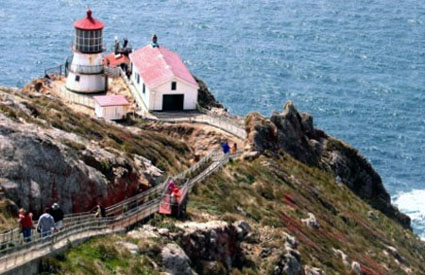 |
The lighthouse at Point Reyes National Seashore (Photo by Matt Mullin). |
“I think the diversity of the park is what draws people,” said Doug Hee, a park ranger at Point Reyes and Bay area resident. “People can camp, hike, go horseback riding or just go out to the lighthouse and enjoy the scenery.”
The ride to the lighthouse is about 45 minutes from the Visitor Center, but once out on the point, the view is worth the drive.
Winding through the middle of park, passing ranch after ranch, Sir Francis Drake Boulevard, named for the first European to land there, offers visitors their first glimpse of the Pacific Ocean.
| The Bear Valley Visitor Center (Photo by Matt Mullin). |
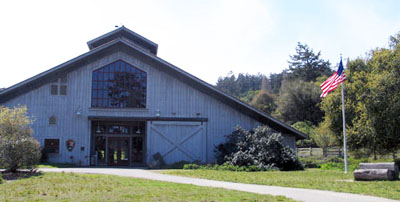 |
“Just the ride itself is worth it,” said Hee. “A lot of people like to bike out there, and some ride horses. Again, there are so many different ways to enjoy Point Reyes.”
The lighthouse, which was first opened on Dec. 1, 1870, has survived several earthquakes.
Located on the western edge of the San Andreas Fault, Point Reyes Peninsula shifted 18 feet to the north in less than a minute during the devastating earthquake of 1906.
The only damage to the lighthouse was that the lens slipped off its track. Although the damage was devastating throughout most of Northern California, lighthouse keepers were able to have the beacon up and running by sunset.
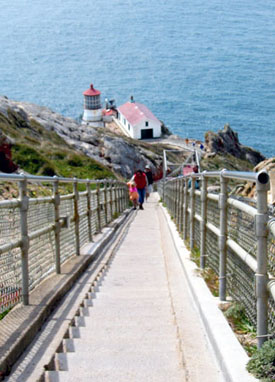 |
Point Reyes Lighthouse, a popular attraction at the park, is not very easy to access. Visitors can get a great view from the lookout at the Lighthouse Visitor Center or walk down the 300 steps to get a closer look (Photo by Matt Mullin). |
“The lighthouse is more than just a part of the history,” Hee said. “It is still in full operation and is necessary for most of the ships that navigate the waters off our coast. It can be dangerous out there, especially if it’s choppy.”
Apart from its rich history, Point Reyes is a haven for those wishing to see diverse wildlife.
Currently there are approximately 80 species of mammals, 85 species of fish, 29 species of reptiles and amphibians, and thousands of aquatic and terrestrial invertebrate species.
In addition, nearly half the bird species of North America, 490 species, have been spotted here.
| Long stretches of wooden fencing separate visitors from the roaming horses of Point Reyes National Seashore near the Bear Valley Visitor Center (Photo by Matt Mullin). |
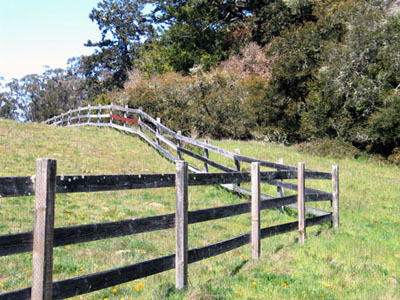 |
In the spring, Point Reyes’s most popular season, the animals return from their hibernation or migration and put on a show for the visitors.
“The spring is the best time to visit,” Hee said. “The abundance of wildlife here is truly amazing, especially this time of year. The whales are migrating through, the seals are pupping, the elk are beginning to come out, and not to mention the 50 or so types of rare plants that are coming into bloom now.”
From the lighthouse, one can spend hours gazing out to the water to watch the gray whales migrate through the park. On any given spring day, one can see more than 50 gray whales.
Just to the east of the lighthouse is Chimney Rock, where visitors can watch from above as thousands of elephant seals begin pupping. This is also the best area to see some of Point Reyes’s rare wild flowers.
On the ride back to San Francisco, Hee recommends that visitors drive down California Hwy. 1 through the Muir Woods, another national park located only 30 minutes south, as it is a much more scenic drive.
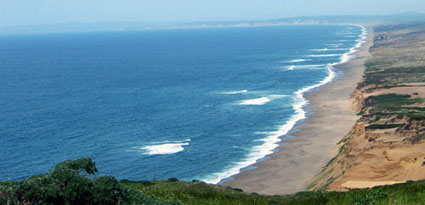 |
Miles of beach stretch along the northern end of Point Reyes (Photo by Matt Mullin). |
“If you have the time, I definitely think you should do it,” said Hee. “If you’ve never seen the Muir Woods, it is definitely something you have to see. Also, [California Hwy. 1] runs directly along the water for much of the drive. It really is a nice drive.”
All in all, Point Reyes National Seashore offers something for everyone. From camping to hiking, horseback riding to relaxing on the beach, visitors are sure to find their fair share of activities.
The Bear Valley Visitor Center, which resembles an old barn, was constructed to blend in with surrounding Olema, a small town with just a few shops and a bed and breakfast. Bear Valley Visitor Center, one of three at Point Reyes National Seashore, can keep guests busy for over an hour, with several exhibits, a video presentation, and a working seismograph.
“There isn’t much you can’t do here,” Hee said. “That’s why I like it, and I think that’s why a lot of people who have been here keep coming back.”
| In the spring, wild flowers begin to paint Point Reyes’s landscape a multitude of bright colors. These California poppies will tint the fields bright orange by summer (Photo by Matt Mullin). |
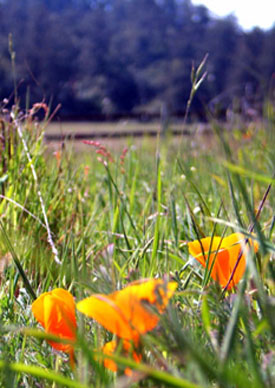 |
If You Go
- Point Reyes National Seashore
Bear Valley Visitor Center
1 Bear Valley Road, Point Reyes Station, Calif. 94956
415-464-5100 - Open: daily all year (except Christmas Day) Monday through Friday 9 a.m. to 5 p.m. Saturdays, Sundays and holidays 8 a.m. to 5 p.m.
- No entrance fees.

Comments are Closed